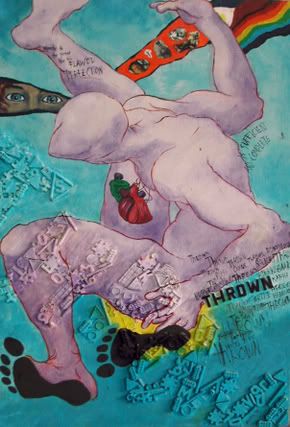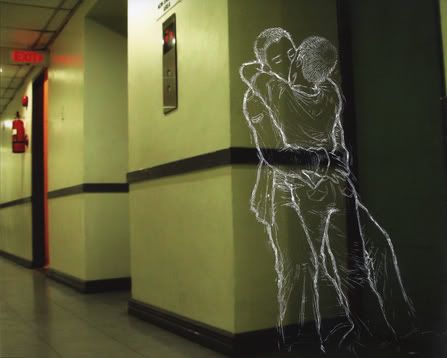[I should have posted this a long time ago...]The grand narrative one ultimately gets, while viewing the artworks and reading the literary pieces that make up "Kabakaba Ba Ka?", may be this:
What can life be like for the butterfly before and
after the fact of the cocoon?Blossoming metaphors abound in this Cebuano paean to difference. Contemplating on that story of metamorphosis -- which pushes further the archetype of living in and out of "the closet" -- one also gets the impression that a nuanced gay and lesbian sensibility, as represented in the works of local artists and writers, have finally come of age in the heart of Southern Philippines.
The eclectic exhibit is foremost a collection of "stories" from the lives of young men and women who just happen to be gay. This, in a time when so much about what Filipinos think of sexuality have indeed changed, and yet so much has also remained the same. Between the cultural phenomena of parlor queens to
Ladlad to Roderick Paulate in drag to
Ang Pagdadalaga ni Maximo Oliveros, what else is there to examine about the gay reality of the Philippines?
It turns out,
plenty. The rest of the country -- that region Manila people invariably call "probinsya" -- has yet to map out its peculiar sexual landscape. "Kabakaba" very well seems to be the answer to that lack. Beyond that, the exhibit can also be seen as an exercise in posing a challenge about forging together a potent identity which does not exactly sit well in the relatively conservative atmosphere of the world outside of Manila.
The exhibit's title in Cebuano asks the viewer, "Are you a butterfly?" -- engaging anyone to weigh this comparison between metamorphosis and the "coming out" experience of gay men and women. It is also a play on the Tagalog question, "Kakaba ka ba?" which invites consideration of the works as testaments to the bravado of the artists, whose participation indeed marks them, hopefully for the better.
In the long run, this is an exhibit that people will talk about from now on as the thing "that got the ball rolling."
"Kabakaba Ba Ka?" features the works of some of Cebu's -- and Davao's and Dumaguete's -- young artists and writers, among them
L. Lacambra Ypil, Russ Ligtas, Ian Rosales Casocot, John Bengan, Ronald Villavelez, Zara Smith, Anna Carla Gonzalez, Ella Melendez, Mitzi Sabanal, Liyo DeNorte, Louise de la Cruz, Clee Andro Villasor, Hali Marmol, Angelica Cabais, Sunshyn Alerre, Chastity Manuel, and
Shem Garcia -- all of whom readily answered the call of artist-poet
James Iain Neish to band together, to "come out" in a groundbreaking exhibit, and to present the world with a view of local gay life not exactly visible to the ordinary Visayan.
Davao-based fictionist John Bengan writes of the experience: "'Kabakaba Ba Ka?' [poses] a question for an audience which has yet to learn about the diversity of the queer population and sample gay pride. Imagining a sense of community among gay people in the city, 'Kabakaba Ba Ka?' reveals the presence of gay artists, their varied concerns and understanding of the queer persona, allowing the subject dimension from a first person perspective."
That perspective is what distinguishes "Kabakaba" from the common run of art exhibits in Cebu City, which are mostly shows by students, feminists, activists with a social realist grind, or middle-aged men who take biblical verses as titles for portraits, landscapes, and still-life's. This may be the first time that Metro Cebu has gathered together queer artists to address gay topics and issues in an exhibit.
What we see in "Kabakaba" are illuminating depictions of Southern gay life all drawn from the personal lives of the artists themselves, relating their own gay experience to illuminate -- but at the same proposing that these are individual stories not meant to speak for the entire gay community of Cebu, or Davao, or Dumaguete. Bengan writes that "each artist asserts, 'this is my story,' and leaves it at that," with the hope that what is realized is that a gay man or woman's life is really no different from anyone else's.
"What we want to say in this exhibit is that, whether you're gay or straight, all of us share a common humanity despite the varieties of lives," says James Iain Neish.
That variety in the stories of gay lives takes spotlight in the form of dances by Russ Ligtas and Liyo DeNorte, as well as poems and short prose works by Bengan, Casocot, Villavelez, and Gonzalez who offers a Bisaya poem "Rape," inspired by a protest poem written by a lesbian friend, and Ypil who comes up with a clever, and funny, poem in Cebuano titled "Bayot."
Beyond words and performances, the paintings, sculptures, and photographs also detail the nuances of queer lives. Sometimes that can mean what is socially serious -- as in the mask metaphors in Mitzi Sabanal's works, and the mixed media cacophony of Ligtas's paintings. In "Thrown," for example, Ligtas presents the queer body naked and vulnerable to what society "throws" at him, that what may be left finally is a heart exposed and teetering on disconnection.
 Russ Ligtas's Thrown
Russ Ligtas's Thrown "Art," F. Sionil Jose once famously wrote, "does not develop in a vacuum; the first artist is responsible not just to his art but to society as well." In "Kabakaba," art may be said to have served that function of commenting, and illuminating, on queer lives.
James Neish says of the exhibit: "People saw it happen, people will remember it happened, and this will be a beginning of something: queer voices speaking about queer things fearlessly. It was a completely positive and blissful experience. I wish I could've taken it all in. For me, the biggest pay-off was seeing the faces of my fellow queer people light up when they looked at the pieces. Larry [Ypil] said that 'art and the truth won,' and the thing that scares and thrills me most is that I can't deny that he might actually be right."

















 4:06 PM |
The Secret Lives of Butterflies
4:06 PM |
The Secret Lives of Butterflies


